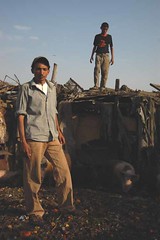 Pugna Porcorum ("The Battle of the Pigs") was written around 1530 by the domenican monk Johannes Leo Placentius from Liège, under the pseudonym "Publius Porcius, Poet". It is a great masterpiece of Latin-language alliteration. In its 253 hexameters, every word begins with 'p'.
Pugna Porcorum ("The Battle of the Pigs") was written around 1530 by the domenican monk Johannes Leo Placentius from Liège, under the pseudonym "Publius Porcius, Poet". It is a great masterpiece of Latin-language alliteration. In its 253 hexameters, every word begins with 'p'.The poem is composed in a style called ‘grotesque’ or ‘Macaronic’ verse, a burlesque form in which two or more languages are mixed. In Pugna Porcorum, Placentius adds Latin endings to words of his local language, and uses them in Latin constructions.
Apparently, it often appears in a compilation of "risqué and bawdy tales, macaronic verse, student drama, and nonsense writings on the subjects of sex, food, wine, women, history, religion, science and the medical and legal professions".
When I studied Latin in secondary school, I waited in vain for a chance to research it, and now I've forgotten too much of my Latin to understand very much of it without tedious dictionary wrestling.
It seems hardly any other people on teh Internets have read and understood it, either, because I can't find any reviews of it that would say anything about the plot. Well, it's probably something nasty, anyway ...
Read the whole poem on Mori's Humor Page.
Porcopolis has some illustrations to the work.

















